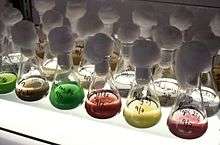Microalgae
Microalgae or microphytes are microscopic algae, typically found in freshwater and marine systems, living in both the water column and sediment.[1] They are unicellular species which exist individually, or in chains or groups. Depending on the species, their sizes can range from a few micrometers (μm) to a few hundred micrometers. Unlike higher plants, microalgae do not have roots, stems, or leaves. They are specially adapted to an environment dominated by viscous forces. Microalgae, capable of performing photosynthesis, are important for life on earth; they produce approximately half of the atmospheric oxygen[2] and use simultaneously the greenhouse gas carbon dioxide to grow photoautotrophically. Microalgae, together with bacteria, form the base of the food web and provide energy for all the trophic levels above them. Microalgae biomass is often measured with chlorophyll a concentrations and can provide a useful index of potential production. The standing stock of microphytes is closely related to that of its predators. Without grazing pressures the standing stock of microphytes dramatically decreases.[3]


The biodiversity of microalgae is enormous and they represent an almost untapped resource. It has been estimated that about 200,000-800,000 species in many different genera exist of which about 50,000 species are described.[4] Over 15,000 novel compounds originating from algal biomass have been chemically determined.[5] Most of these microalgae species produce unique products like carotenoids, antioxidants, fatty acids, enzymes, polymers, peptides, toxins and sterols.
Characteristics and uses

The chemical composition of microalgae is not an intrinsic constant factor but varies over a wide range, both depending on species and on cultivation conditions. Some microalgae have the capacity to acclimate to changes in environmental conditions by altering their chemical composition in response to environmental variability. A particularly dramatic example is their ability to replace phospholipids with non-phosphorus membrane lipids in phosphorus-depleted environments.[6] It is possible to accumulate the desired products in microalgae to a large extent by changing environmental factors, like temperature, illumination, pH, CO2 supply, salt and nutrients. Microphytes also produce chemical signals which contribute to prey selection, defense, and avoidance. These chemical signals affect large scale tropic structures such as algal blooms but propagate by simple diffusion and laminar advective flow.[7][8] Microalgae such as microphytes constitute the basic foodstuff for numerous aquaculture species, especially filtering bivalves.
Photosynthetic and chemosynthetic microbes can also form symbiotic relationships with host organisms. They provide them with vitamins and polyunsaturated fatty acids, necessary for the growth of the bivalves which are unable to synthesize it themselves.[9]
In addition, because the cells grow in aqueous suspension, they have more efficient access to water, CO2, and other nutrients. Microalgae play a major role in nutrient cycling and fixing inorganic carbon into organic molecules.
While fish oil has become famous for its omega-3 fatty acid content, fish don't actually produce omega-3s, instead accumulating their omega-3 reserves by consuming microalgae. These omega-3 fatty acids can be obtained in the human diet directly from the microalgae that produce them.
Aquaculture
A range of microalgae species are produced in hatcheries and are used in a variety of ways for commercial purposes.
Studies have estimated the main factors in the success of a microalgae hatchery system to be;
- the dimensions of the container/bioreactor where microalgae is cultured,
- exposure to light/irradiation, and
- concentration of cells within the reactor.[10]
See also
References
- Thurman, H. V. (1997). Introductory Oceanography. New Jersey, USA: Prentice Hall College. ISBN 978-0-13-262072-7.
- "Microscopic algae produce half the oxygen we breathe". abc.net.au. 25 October 2013.
- Thrush, Simon; Hewitt, Judi; Gibbs, Max; Lundquist, caralyn; Norkko, Alf (2006). "Functional Role of Large Organisms in Intertidal Communities: Community Effects and Ecosystem Function". Ecosystems. 9 (6): 1029–1040. doi:10.1007/s10021-005-0068-8.
- Starckx, Senne (31 October 2012) A place in the sun - Algae is the crop of the future, according to researchers in Geel Flanders Today, Retrieved 8 December 2012
- Cardozo, Karina H.-M.; Thais, Guaratini; Marcelo P., Barros; Vanessa R., Falcão; Angela P., Tonon; Norberto P., Lopes; Sara, Campos; Moacir A., Torres; Anderson O., Souza; Pio, Colepicolo; Ernani, Pinto (2006-06-29). "Metabolites from algae with economical impact". Comparative Biochemistry and Physiology C. 146 (1–2): 60–78. doi:10.1016/j.cbpc.2006.05.007. PMID 16901759.
- Bonachela, Juan; Raghib, Michael; Levin, Simon (Feb 21, 2012). "Dynamic model of flexible phytoplankton nutrient uptake". PNAS. 108 (51): 20633–20638. doi:10.1073/pnas.1118012108. PMC 3251133. PMID 22143781.
- Wolfe, Gordon (2000). "The chemical Defense Ecology o Marine Unicelular Plankton: Constraints, Mechanisms, and Impacts". Biology Bulletins. 198 (2): 225–244. CiteSeerX 10.1.1.317.7878. doi:10.2307/1542526. JSTOR 1542526. PMID 10786943.
- "growing algae". WUR. Retrieved 2009-05-19.
- "ENERGY FROM ALGAE (includes scientific names)". ifremer. Archived from the original on 2006-11-28. Retrieved 2006-09-13.
- M. Tredici & R. Materassi (1992). "From open ponds to vertical alveolar panels: the Italian experience in the development of reactors for the mass cultivation of phototrophic microorganisms". Journal of Applied Phycology. 4 (3): 221–231. doi:10.1007/BF02161208.
External links
| Wikimedia Commons has media related to Microphyte. |
- NOAA, DMS and Climate
- Microalgae concentrates
- Microalgae research
- "From Micro-Algae to Blue Oil", ParisTech Review, Dec. 2011
- Company

